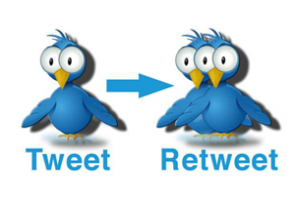Have an idea or message you want to go viral in a hurry? Then it’s time to start taking Twitter seriously.
There are many reasons why people share content on Twitter. Today, I want to focus on one area that will get your message out quickly and reach a broader audience than you can probably anticipate: retweets. How do you get more people to retweet your content, and how can you meet or exceed various marketing goals by encouraging it? Read on…
1. Keep It “100”
I’ve shared this strategy numerous times in the past, but if this is the first of my blogs that you’re reading, I’m mentioning it again here (and mentioning it first) because it is the most effective and most underestimated of retweet strategies.
Simply put, you need to wrap your tweets to 100 characters, not 140. Why? People don’t simply press a button and retweet. They add their own comments, they add @mentions … they do “stuff” with it. If you’ve already exhausted all 140 characters, sure you’ll get some retweets, but you’ll probably miss out on reaching a number of people within your target demo. You also want to have a few characters in reserve for a link of your own (that doesn’t have to count toward the 100).
Think about it: If someone sees one of your tweets and thinks, “Wow! So-And-So would really LOVE this!” that person is far more likely to send a retweet with an @mention. No characters to spare? That person – the one who is likely to want to receive your message – might not. In fact, there’s a much greater probability that the message will be missed if it can’t be shared with specific people. Keep it to 100 characters (or thereabouts – 103 and 96 are OK, too). It’s a great strategy!
2. Utilize Calls to Action
This might seem obvious, but… are you asking people to retweet your content? A CTA to retweet results in a much higher average retweet rate than a tweet that doesn’t have one.
Now be careful, though, because you don’t want to send off every tweet with an appeal to share. It makes you look desperate. Use a variety of formats and mix up the content. When you have something specific you want your audience to do (like retweeting), the only way they’re going to do it is if they’re told.
One last word about calls to action: It’s always a good idea to have a variety of phrases so you’re not constantly soliciting retweets the same way. I hate to say it, but sometimes you need to fool your audience into thinking you’re saying different things while sending the exact same message.
3. Be Mysterious
Using phrases in the vein of, “This changes everything!” with a bit.ly link (or something similar) that doesn’t give away the content on the other side will get retweeted quite a bit, provided you deliver something good.
Try to think of phrases that make certain promises without giving away details. “You’re going to want to share this” is a great template phrase that you can use often, and it serves several purposes: It creates that atmosphere of mystery, and it also presents a call to action.
Now, please understand: There is a difference between mystery and ambiguity. If you’re only going to be vague, not mysterious, no one is going to play the game. Mystery piques interest; it doesn’t make the reader think, “Huh?” so choose your words wisely (or get a copywriting company on the job pronto!).
4. Harness the Power of Hashtags
Hashtags can be powerful weapons in your retweet strategy, but only if you use them well. For example, you can’t just invent a hashtag and expect it to result in retweets. If yours is a major brand or corporation, you might be able to get away with it, but most SMBs need to put a little more thought and effort into how to hashtag effectively.
You may not realize it, but there are hashtag research tools out there, just like there are for keywords. You do not need to rely on your own imagination or intuition. All you need is to plug in a few words related to your business, product, brand, or even just the content of your tweet, and you can get all the information you need about which hashtags will be the most likely to achieve both front- and back-end results. The front-end is that a popular hashtag gets retweeted. The back-end result is that lots more people see your tweet based solely on the hashtag.
5. Timing Is Everything
It is well to your advantage to utilize “best time tools” that analyze traffic patterns with your tweets and start aligning when you tweet with what you tweet. Simply put, the law of averages by itself can play a significant role in the number of retweets to get. How? Well, if more people see it, the odds of it getting retweeted also increase, right? Learning when to post and then using the power of automation to ensure that your tweets go out at the right time can drastically increase your retweets, along with your reach.
Final takeaway: Capturing retweets matters. It is one major part of how successful marketers build a solid social media presence, and if you aren’t doing what you should to increase retweets, you’re not capturing the size of audience or doing the level of business your efforts deserve.
